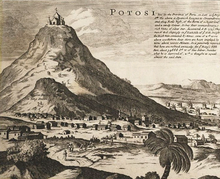This article needs additional citations for verification. (June 2015) |

The Sierra de la Plata ("Mountain of Silver") was a mythical source of silver in the interior of South America. The legend began in the early 16th century when castaways from the Juan Díaz de Solís expedition heard indigenous stories of a mountain of silver in an inland region ruled by the so-called White King. The first European to lead an expedition in search of it was the castaway Aleixo Garcia, who crossed nearly the entire continent to reach the Andean altiplano. On his way back to the coast, Garcia died in an ambush by indigenous people in Paraguay, but survivors brought precious metals back to corroborate their story.
The legend inspired other expeditions, all of which ended in failure. However, numerous expeditions allowed Spanish Conquistadors to deeply explore the South America portion south of Brazil. The outposts founded during the expeditions gradually evolved into Buenos Aires and Asunción, the lands colonized by the Spanish became Viceroyalty of the Río de la Plata.
Eventually, a Spanish expedition traveling from Peru in 1545 found the Cerro Rico de Potosí in Bolivia, a massive silver deposit deep in the Andes. It is possible that the legend of the Sierra de la Plata was based on the silver mines of Cerro Rico de Potosí.
The river Río de la Plata (literally "Silver River") and the country of Argentina (from the Latin argentum, "silver") both take their names from the legend.